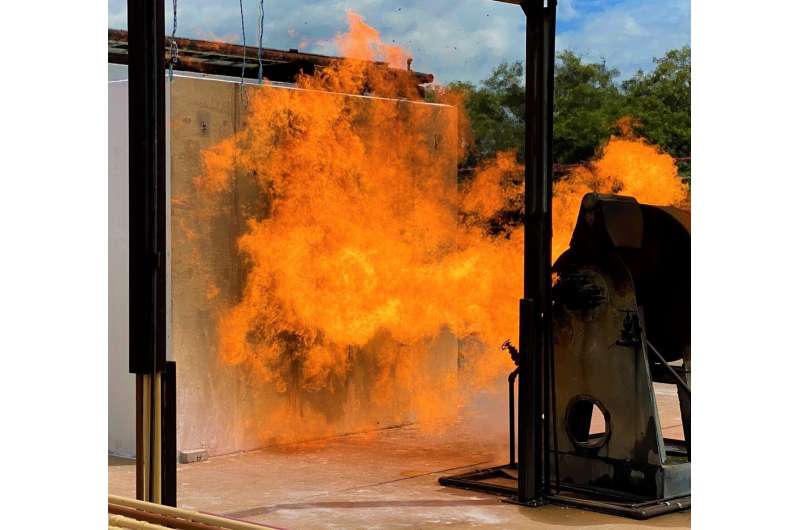This article has been reviewed according to Science X's editorial process and policies. Editors have highlighted the following attributes while ensuring the content's credibility:
fact-checked
trusted source
proofread
Bushfire safe rooms may save lives

QUT researchers have built and tested a bushfire safe room that exceeds current Australian standards and could keep people alive or protect valuables when evacuation is no longer an option.
Led by Dr. Anthony Ariyanayagam from the QUT Faculty of Engineering, the full-scale safe room was constructed at the Queensland Fire and Emergency Services (QFES) facility in Lytton and tested under simulated bushfire conditions.
Built with cavity insulated light gauge steel framed walls, the roof lined externally with Autoclaved Aerated Concrete panels and internally with fire-rated gypsum plasterboards, during testing the external wall temperature reached a maximum of 958 °C at 30 mins during peak flame exposure, while internal surfaces remained under 29°C with less than 1°C rise in internal air temperatures.
The results have now been published in the paper "Evaluating the bushfire resistance of a safe room using full-scale experiments" in the journal Structures.
"The bushfire safe room demonstrated excellent bushfire heat resistance and is a viable solution for storage of valuables," Dr. Ariyanayagam said.
"In theory, people could survive in this shelter for up to two hours, but we need to test other conditions like air quality before recommending human survivability too," he said.
Australia recorded 33 deaths and more than 3,000 houses damaged during the Black Summer Fires of 2019/2020.
Dr. Ariyanayagam said limited studies had investigated bushfire performance of buildings, but full-scale experiments on heat transfer and structural performance of bushfire safe rooms using realistic bushfire exposure conditions had not been conducted before.
"During past bushfire events, an estimated 30% of all recorded bushfire fatalities happened due to late evacuations, therefore, increasing the need for standardized shelters as a last resort option when evacuation is no longer safe," he said.
"Short notice, blocked roads or exits, unknown fire directions or speed, and psychological attachment to a house or belongings are among the reasons someone might find themselves needing to a shelter."
Dr. Ariyanayagam said affordable land, lifestyle changes, population growth had also increased the number of houses at the urban-bush interface—exposing more people to bushfire risk.
"The main bushfire attack mechanisms include direct flame contact, radiant heat and ember attacks. Buildings located near vegetation such as forests are subjected to all three of those threats," he said.
"Building materials used in bushfire flame zones only have a standard recommendation of 30 min standard fire exposure (AS1530.4).
"But, unlike a structural fire, bushfire temperatures can reach 1100°C in a very short time and building performance can be highly affected by this sudden increase."
Dr. Ariyanayagam said that after the 2009 Black Saturday fires, the Australian Building Codes Board released performance standards for the construction of private bushfire shelters, but they were not mandatory and more research was needed to improve them.
"The performance standard for private bushfire shelters specify that an able-bodied person should be able to stay in a bushfire shelter for about one hour to withstand the fire front but, as conditions vary, they might need to stay in there for few hours," he said.
Research team member Sahani Hendawitharana said they used an LP gas-fired burner to generate three bushfire phases—approaching fire, fire immersion, and post-fire radiant heat from a nearby forest fuel and burning building situated 10 m away from the safe room.
"We used heat fluxes proposed by the CSIRO and the Australian Building Codes Board (ABCB) performance standards to simulate real bushfire exposure conditions," she said.
"Our test duration was 67 mins, but temperature readings were logged on the fire side wall for more than two hours to measure the heat transfer during the cooling phase."
The tests were the first to demonstrate a viable bushfire shelter that would survive an approaching bushfire and the radiation from a nearby building fire.
"However, while the full-scale tests added to knowledge of building structure bushfire performance, a fire front would be more than 100 m wide and only testing a vacant structure in a real bushfire would provide definitive results," Dr. Ariyanayagam said.
More information: Sahani Hendawitharana et al, Evaluating the bushfire resistance of a safe room using full-scale experiments, Structures (2023). DOI: 10.1016/j.istruc.2023.01.126
Provided by Queensland University of Technology



















